Spend any time exploring Paris and you’ll probably notice something a bit like this:
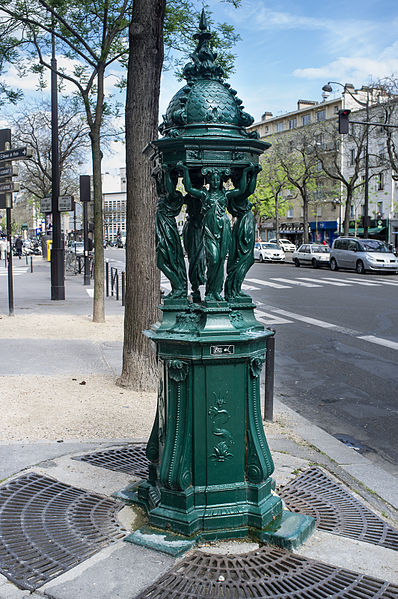
You’d be forgiven for thinking these are purely decorative, as many fountains are. Indeed, they are a beautiful part of the Paris streetscape. I never thought they served any other function until I saw a notice attached to one, from municipal water company Eau de Paris, advertising it as a source of drinking water.
Intrigued, I dug into the history of these fountains. It turns out they owe their existence (at least in part) to the 19th-century temperance movement. English philanthropist Richard Wallace had lived in Paris during the siege of 1870-71, and had witnessed – and helped alleviate – the extreme hardship during that time. He had also noticed that, especially in the wake of wartime destruction of aqueducts, potable water was a precious commodity, and that many locals drank alcoholic drinks instead. Beer and wine were often cheaper even than the dirty water, pulled straight out of the Seine, that vendors peddled in the streets. At the same time, even as the siege restricted meat stocks until the options available dwindled to cat, rat and zoo elephant, one product that was readily available was wine, thanks to the well-stocked warehouses at Bercy. Wallace witnessed widespread public drunkenness, not only in the impoverished population but also among soldiers stationed in the city.
![Translation of the menu: Siege bread; horse soup; dog cutlets; ragout of cat; donkey; fricasses of rats & mice; fillet of mule; *roast ostrich; &c. &c. &c. Mr Washbourne, of the United States Embassy was present at this Dinner in Paris which was one of the last given before the Capitulation. *The whole of the Animals and Birds of the Jardin Acclimitation [sic] were bought by an English Butcher, of the Faubourg Saint Honore, just before the Siege, and were all sold by him during the Siege at the rate of 25 Francs per lb. He is said to have realized a very large fortune by the transaction.](/assets/images/siege-menu.jpg)
If the locals had a clean, safe alternative, Wallace reasoned, perhaps fewer of them would turn to drink. This was the logic of temperance fountains, which were popular in the US and UK during this period. To this end, he commissioned a series of 70 drinking fountains around Paris. But he wasn’t content with merely providing water. As an art collector, he had a keen eye for sculpture, and wanted the fountains he funded to be works of art rather than mere utilitarian taps. To this end, he sketched a design rich in symbolism and then hired sculptor Charles-Auguste Lebourg to perfect it.
The fountains are a great example of how form and function can complement one another. He wanted the fountains to be clearly visible, without disrupting the visual harmony of the cityscape. He wanted them to be easy to use, weather-resistant and cheap enough to be widespread. But he also wanted them to be beautiful. This combination of features ensured their longevity: something less sturdy or more difficult to maintain would soon have fallen into disrepair; something less attractive would likely have been ripped out and melted down at some point over the last century. The Wallace fountains have stood the test of time.
Wallace originally commissioned 40 large-model fountains and 10 wall-mounted ones, installed from 1872. The large model proved popular and Wallace added 20 more over the next decade. His original sketches for the large model were inspired by the Fontaine des Innocents, a historic fountain in the centre of the city. Four caryatids (columns in the shape of women), standing on an octagonal base, support a dolphin-adorned dome, their backs turned to a continuous stream of water. As described here, each caryatid is different and represents a different virtue among kindness, simplicity, charity and sobriety. Unfortunately it’s unclear which one represents which.
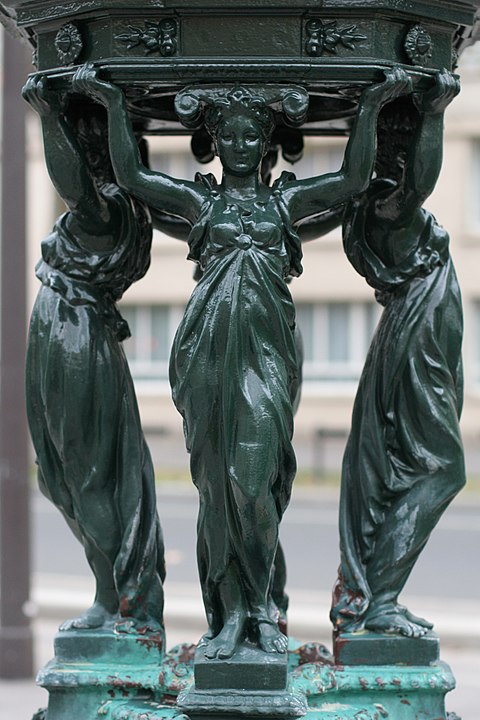
While many of these large-model fountains remain today, only one wall-mounted example survives, in the fifth arrondissement. Two other designs of free-standing fountain were introduced later but are nevertheless referred to as Wallace fountains. One, the colonnade model, is a simplification of the large model in which the caryatids are replaced by straight columns. Only two of these can be found today, in the 16th and 17th arrondissements. The other is the small model, much simpler and with a push button instead of a steady stream. These are found in many of Paris’s garden squares.
Most of the Wallace fountains – of all models – are a shade of dark green that’s familiar in Paris. Used everywhere from kiosks and benches to fences and metro entrances, this colour was historically very popular with the local authorities for its natural look, which blends in with the city’s greenery. There are, however, a handful of uniquely coloured fountains, either repainted or newly installed. This seems to be restricted to outer districts where the surrounding streetscape is more modern, as it would offend certain sensibilities in more historic spots. Personally, I think it’s a great way to draw attention to these wonderful items of Paris’s living heritage.
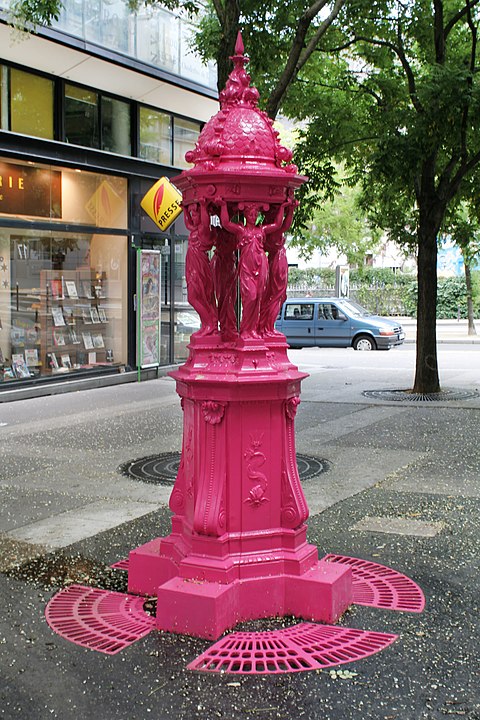
Fast-forward to today, and clean water is readily available in every home. The fountains no longer serve to reduce public drunkenness. But they’re an invaluable tool in the local authorities’ attempts to discourage bottled water purchases. Each year, the French drink 9.3 billion litres of bottled water. Less than 50% of plastic bottles thrown out here end up recycled, meaning the waste plastic is destined for landfill or worse. As one 2016 poster campaign highlighted, 9 out of 10 marine birds will have ingested plastic by 2050. And if France is to meet its target of net-zero CO2 emissions by 2050, it’s important to limit emissions from the production and transport of bottled water.
Many people are apparently convinced (likely mistakenly) that bottled water is healthier and tastes better. But even those of us who are happy to drink tap water often find ourselves buying a bottle while out and about. Being able to refill a bottle from a fountain reduces this need significantly, particularly for tourists. Eau de Paris, the publicly-owned company which took control of water supply in 2009, has embarked on a public information campaign encouraging people to drink tap water. In addition to drawing attention to the Wallace fountains, they have rolled out new fountains, many of which are rather easier to drink from without a bottle, and some of which even provide sparkling water.
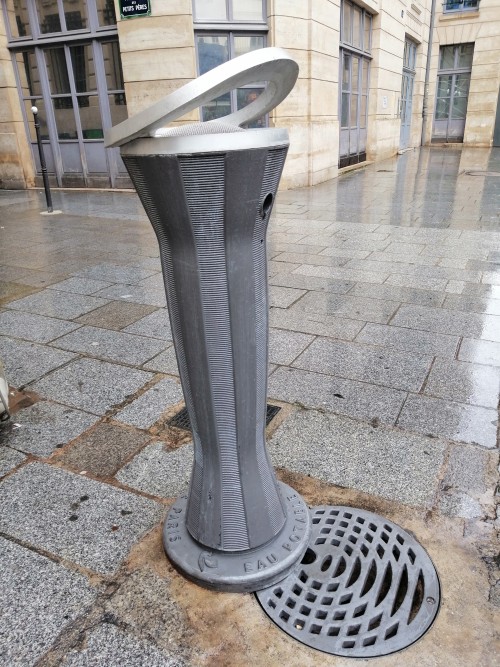
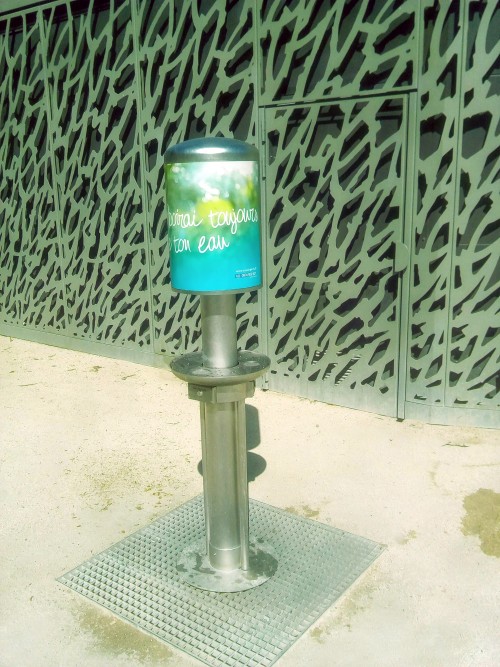
If we’re thinking ecologically, it would be remiss not to consider the waste of water caused by the fact these fountains run continuously. Eau de Paris is trialling a solution to this problem involving adding simple push buttons. Unfortunately it’s unclear at this stage whether this will be rolled out, as the trial has revealed hygiene problems due to water being left stagnant. Let’s hope a solution can be found which reduces water consumption while respecting the heritage of these works of art.
If you’re ever strolling around Paris’s streets, think twice before throwing your bottle away – save it and reuse it! In refilling from a Wallace fountain, you’ll be sharing in an activity that goes back over a century.
 Fabric of Paris
Fabric of Paris